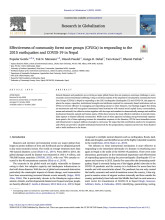/ library resources
Showing items 1 through 9 of 34.Expanding human population and economic growth have led to large-scale conversion of natural habitat to human-dominated landscapes with consequent large-scale declines in biodiversity.
Study of land use/cover change and its driving forces is one of the most significant fields in global environmental change research.
The status of many invasive plant species that are also of high commercial value is contentious. Management of negative impacts depends on the support and co-operation of people who regard the species as an asset.
Land degradation has been a major political issue in Java for decades. Its causes have generally been framed by narratives focussing on farmers’ unsustainable cultivation practices. This paper causally links land degradation with struggles over natural resources in Central Java.
Natural disasters and pandemics are evolving as major global threats that are posing an enormous challenge to socio- economic and environmental wellbeing.
The fragmentation of construction land due to decentralised urban development, disorderly mixed land use, and large-scale transportation infrastructure poses a threat to urban integrity.
Many ongoing processes in today's landscapes impact our environment considerably. Thus, it is enormously important to gather information on qualitative characteristics of our landscapes in order to effectively counteract the negative developments.
The implicit hydrologic dimensions of international efforts to mitigate climate change, specifically potential impacts of the Clean Development Mechanism-Afforestation/Reforestation (CDM-AR) provisions of the Kyoto Protocol (KP) on global, regional and local water cycles, are examined.
Conversion of native prairie land for agricultural production has resulted in significant loss and redistribution of soil organic matter (SOM) in the soil profile ultimately leading to declining soil fertility in a low-productivity semiarid agroecosystem.
Pagination
Land Library Search
Through our robust search engine, you can search for any item of the over 73,000 highly curated resources in the Land Library.
If you would like to find an overview of what is possible, feel free to peruse the Search Guide.



